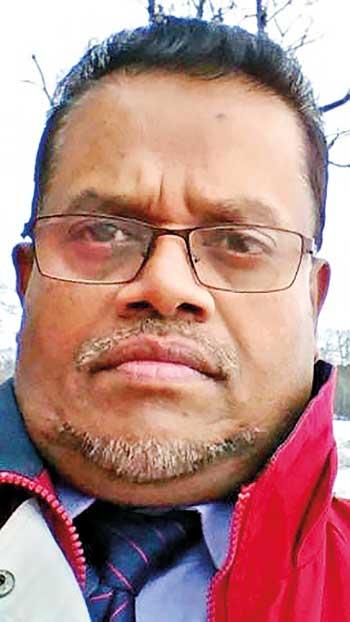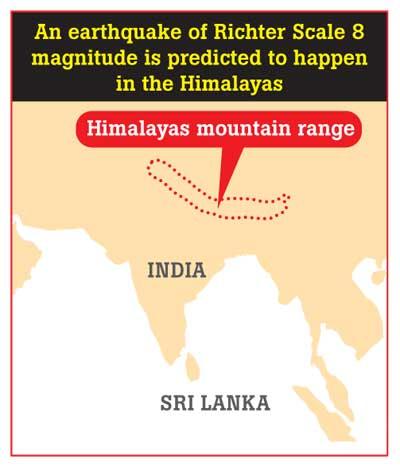10 Mar 2023 - {{hitsCtrl.values.hits}}
The had an interview with Athula Senaratne, Senior Professor of the Geological Department, University of Peradeniya on the effects Sri Lanka could experience in the event the predicted earthquake-expected to read 8 magnitudes in the Richter Scale- in North India’s Himalayan region does happen. There are warnings that this natural catastrophe is expected within the first two weeks of March.
the predicted earthquake-expected to read 8 magnitudes in the Richter Scale- in North India’s Himalayan region does happen. There are warnings that this natural catastrophe is expected within the first two weeks of March.
Excerpts of the interview
 Q If North India experiences an 8 magnitude quake as predicted by Indian geologists within the first two weeks of March, what will be its impact on Sri Lanka?
Q If North India experiences an 8 magnitude quake as predicted by Indian geologists within the first two weeks of March, what will be its impact on Sri Lanka?
That earthquake is predicted on the boundary of the plate where Sri Lanka is located. If there is an earthquake on the plate boundary of North India, it would be felt in Sri Lanka as well. The Himalayas are located at the edge of the Indian plate. Sri Lanka is also located on this plate boundary. There is another plate boundary below Sri Lanka and that has no importance. Earthquakes occurring on the northern plate boundary are very strong. That is why they are felt in Sri Lanka. In 2020 we felt an earthquake of the magnitude of 5 when it occurred on the northern border of India. It was felt in Colombo and all the buildings in Colombo are built using rocks. They are built on a solid foundation. Therefore, there is no risk. But quakes will be felt. The National Geophysical Research Institute (NGRI) of India has forecast that an earthquake will occur in the first or second week of March based on their research. Accordingly, if any quake occurs, it would be felt in Colombo and Jaffna districts.
Q According to Indian geologists, will the earthquake have a magnitude of 8 on the Richter scale?
According to the NGRI of India if an earthquake of the magnitude of 8 occurs it would be 3000 times more powerful than an earthquake that has a reading of 5 on the Richter scale. We felt a quake of the magnitude of 5. Therefore if an earthquake of the magnitude of 8 occurs, Colombo would definitely feel it. As Jaffna is close to India, that area will also feel this quake.
Q According to Indian geologists, if this earthquake happens, would it be felt only in Colombo and Jaffna? What about the areas in the North towards Mannar and from Colombo to the South or inland?
Its impact can be felt not only in Colombo and the North, but anywhere in the land. This will be determined by how deep the rock layer is from the ground level. If the bedrock is too deep, the energy from a shock will be absorbed by the upper soil layer. Then the people who live above it will not feel it much. But if the soil layer is very thin, the areas located very close to the bedrock are more likely to feel this vibration. So, if the quake is as powerful as predicted, it will be felt in many places in Sri Lanka. If a house is built on a rock, the earthquake will be felt more and for houses or other buildings that are built on soil, the impact will be less as the soil absorbs the shock. That is the reason why an earthquake can be felt in one place and not in another place.
Q An earthquake of 5 magnitude occurred near Colombo on 14-04-1615 killing 2000 people and damaging 200 houses. Old gazettes reveal that the wall of Colombo Fort collapsed. So, if an earthquake of the magnitude of 8 occurs, will Sri Lankans have to face much more severe consequences? If so, how can people ensure their safety?
According to Indian geologists in the case an earthquake of the magnitude of 8 were to happen Sri Lanka should feel it. It will only last for a few seconds. If you feel it while you are inside a multi-story building or another building, you should go outdoors as soon as possible. Do not use elevators when coming down from a multi-story building.
Q Are you certain that the buildings in Sri Lanka are strong enough to withstand this quake?
We cannot say for sure that the buildings in Sri Lanka are built to withstand an earthquake. It is unthinkable to ensure that our existing buildings are designed in accordance with the regulations to withstand an earthquake.
Q Are the recent earthquakes in the Wellawaya and Hambantota areas early signs of this earthquake forecast by Indian geologists?
There is a clear difference between the recent earthquakes in Wellawaya and Hambantota and the earthquakes occurring in Northern India. The quakes in Northern India occurred on the plate boundary. But the earthquakes in Wellawaya and Hambantota areas are not related to any recognised border. Therefore there is no need to worry about that.
Q Sri Lanka’s reservoirs are located on a plate with a crack. In such a case, can this earthquake of 8 on the Richter scale have an impact on large reservoirs?
We are on the edge of a plate prone to earthquakes. If a tremor occurred, it would be felt in many places on the ground. As I mentioned earlier, tremors can be felt more if a building is located closer to the bedrock. There are very deep cracks on the earth’s surface where our land is located. Those deep cracks can feel these types of earthquakes. I cannot say that there will be any damage to the reservoirs.
If there is an earthquake on the plate boundary of North India, it would be felt in Sri Lanka as well. The Himalayas are located at the edge of the Indian plate. Sri Lanka is also located on this plate boundary. There is another plate boundary below Sri Lanka and that has no importance. Earthquakes occurring on the northern plate boundary are very strong
Q If the earthquake that is predicted in the North Indian plate somehow spreads to the coastal region, would there be a tsunami?
This quake is predicted to take place far from the sea. Therefore, a tsunami situation won’t develop at all.
Q An opinion surfaced lately claiming that the recent earthquakes around the world were caused due to the influence of the stars and the moon. It was about the tremors that happened and are happening. What is your opinion?
We are at the northern boundary of the plate. That plate is about 10,000 kilometres long. It extends to the Himalayas, Nepal and Italy. The earthquake that happened in Israel is different. Around 100000 earthquakes occur in the world every day. Often there are tremors everywhere. How do they occur? We are yet to discover the manner in which they occur. We have not understood that so far. Most people learn about earthquakes only after they happen.
Q If so how can Indian geologists state the exact time and place of an earthquake?
Indian geologists have made a shocking statement. If they can predict the exact time and place of an earthquake, we should appreciate them. If it is possible to tell the exact place of an earthquake as they have, we should develop that technology for further use. If this earthquake is really going to happen, we need to see how it would affect our country. We cannot say that their statement is false because they have done their research. Therefore, we need to be careful. Although the quake doesn’t pose a huge danger, we have to remain vigilant. Even if there is no major damage to our country we will still feel this tremor. 200 people died in an earthquake in Sri Lanka in 1615. That earthquake may have happened in our country or at the Himalayas. A magnitude 5 earthquake may have shaken the ground and damaged our buildings. Those buildings may have not been properly constructed. They may not have been strong enough. But if this tremor happens we will feel it. There will be no serious danger. But we have to be careful.
Q When an earthquake occurs do we have any technology in our country to detect it or to predict its occurrence? Are you satisfied with the current technology?
There’s no proper study on earthquakes in our country. We confirm our data after an earthquake. For the last 30 years we only had 4 seismometers in our country. Those four are placed in Hakmana, MahaKanadarava, Peradeniya and Pallekele. We studied earthquakes with the little data obtained from these four. Last year, when many small earthquakes occurred in the Central Province, we told the government to install seismometers to cover the entire country. Accordingly, a seismometer is being installed that can monitor earthquakes throughout 24 hours. The Bureau of Geological Survey and Mining is in charge of that. Much data is obtained from those seismometers. We are monitoring that data. As our database grows, we gain more knowledge. Based on that, we predict about earthquakes that can occur in several regions. We inform about the tremors that occur along our tectonic plates and along the cracks in the interior of our country, as well as tremors occurring somewhere in the world and its impact on us. With our existing technology, we can predict earthquakes and whether there would be an impact. But we do not have the capability to predict the magnitude. What we can say is whether we will feel the tremor or not.
Q Around the year1800 an earthquake of the magnitude of 6.2 occurred in Trincomalee. Does that region also belong to the northern region of India?
There is a plate boundary that runs from Trincomalee to Ussangoda. That plate boundary is considered dead. Sri Lanka was in Antarctica 150-200 million years ago. At that time, Antarctica, Africa, the Indian region, and the Australian region were one continent. That continent was called Gondwanaland. At that time, there was a fissure that went through the middle of Gondwana. It goes through the middle of our country. But those plates are inactive. This plate, which has been inactive for millions of years, indicates the line between the central hills and the eastern coastal area. That line runs from Trincomalee to Ussangoda. That plate may reactivate. We cannot say exactly how or when it will happen. Professor P. B. Dissanayake said in 1984 that this was a dead plate. The hot water wells in Sri Lanka were shown as evidence. When the mineral deposits in Sri Lanka, and the Buttala iron deposit that I discovered are marked you can see that they are on the same plate.
Q Is Hambantota also located in that region?
That line comes all the way to Hambantota. Also, if all the earthquakes in Sri Lanka are marked on a map, they would be found along the aforementioned line.
Q Through which regions does that line fall?
This line runs from Trincomalee to Manampitiya, from Minipe to Bibila, from Bibila towards Wellawaya on the west and from there, it turns to the south and goes to Ussangoda. All the earthquakes in Sri Lanka happen along that line.
08 Jan 2025 29 minute ago
07 Jan 2025 7 hours ago
07 Jan 2025 7 hours ago
07 Jan 2025 8 hours ago
07 Jan 2025 07 Jan 2025